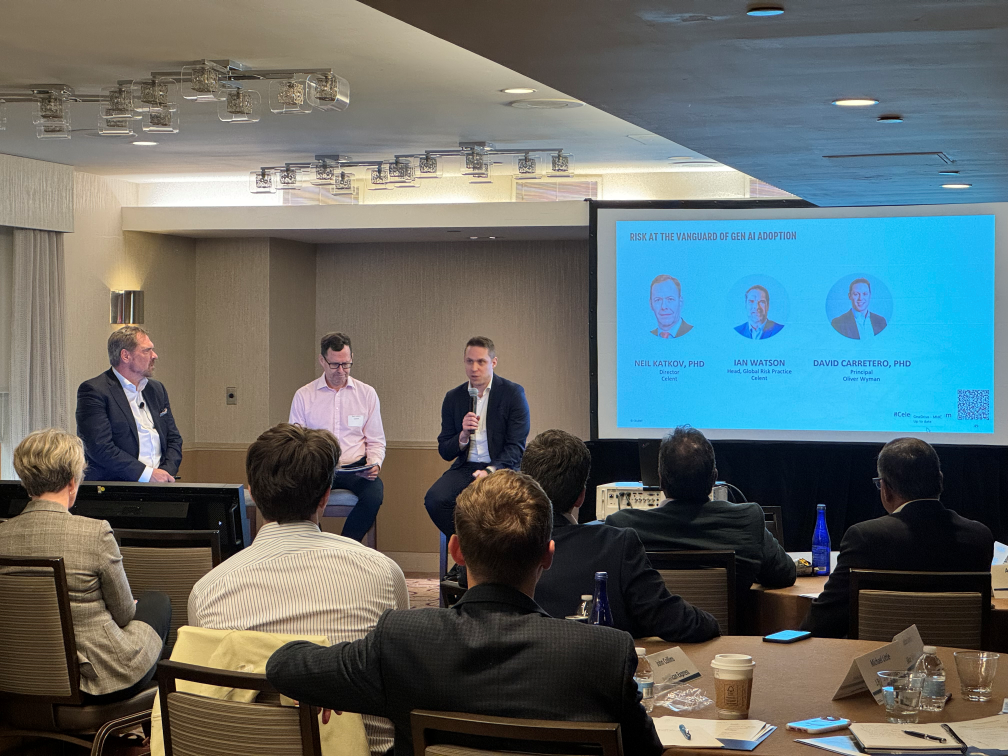セレント生成AIシンポジウム:リスク/ コンプライアンス関連業務における生成AIの可能性
Moving Beyond LLMs to Quantitative Transformer Models
As part of Celent’s ongoing coverage of technology and business trends in genAI, Celent held its Generative AI Symposium in New York last week. The event featured banks and insurers discussing current areas of focus for generative AI, presentations and discussion led by Celent analysts, as well as a number of vendor demonstrations of genAI-enabled solutions. The fully-subscribed event was attended by industry practitioners and, judging by the questions and comments during the Symposium sessions as well as the networking breaks, many of the attendees are deeply involved in leveraging genAI for their lines of business.
Along with my colleagues Ian Watson, Head of Risk at Celent, and David Carretero of Oliver Wyman, I participated in a session focused on exploring the potential of genAI for risk and compliance, under the bold title “Risk Is at The Vanguard of GenAI Adoption.”
This claim is substantiated by several Celent surveys this year showing that risk and compliance is among the most active areas for genAI, with 65% of forward-looking insurers and 64% of banks pursuing genAI use cases for risk functions (see Celent’s report GenAI-oneers in Risk and Compliance).
This should not be surprising to risk professionals, who for some years have already been applying classic AI techniques including machine learning and natural language processing (NLP) to risk functions including anti-money laundering (AML), fraud and credit risk. The heavily manual nature of much risk and compliance work—think of the large teams of compliance analysts sifting through AML alerts, the overwhelming majority of which are still false positives—is also a compelling motivation for risk professionals to eke every drop of efficiency they can from new technologies such as genAI. Among risk functions, genAI is seen by financial institutions as having the most impact on fraud, operational risk and regulatory change management, in that order.

Much of the line-of-business discussion at the symposium was around the use of virtual genAI assistants to enhance customer interaction and experience either by supporting call center reps or providing enriched self-service directly to customers. GenAI adoption in the back office function of risk and compliance looks very different.
GenAI-enabled virtual assistants are indeed playing a role in supporting compliance analysts, with vendors including SymphonyAI, Lucinity, Quantexa and Greenlight rolling out copilots for financial crime analysts. At the same time, though, risk offices are forging ahead by applying genAI to the analytics underlying anti-financial crime, operational risk and credit risk functions. Celent’s genAI survey results prioritized detection as a leading use case for genAI in risk and compliance. Leading banks that are working with genAI in this way include Deutsche Bank (for customer risk assessment), Barclays (to reduce false positives), Goldman Sachs (to analyze financial statements to support credit risk) and HSBC (to enhance financial risk models).
This brings up the question of what’s next for generative AI in risk and compliance. An important development that I see on the horizon is an expansion in the use of generative AI beyond language models to work on quantitative data directly. Current approaches to detection hinge on using large language models to query unstructured data, such as negative news, in order to support risk assessments or to provide additional signals to supplement rules and machine learning models.
A new frontier is using the attention-based transformer technology that underpins generative AI to analyze large volumes of structured and quantitative data directly. This and similar approaches are currently being developed by anti-financial crime vendor Featurespace—which is about to be acquired by Visa—as well as by Visa’s competitor MasterCard to enhance their anti-fraud models. Expanding the application of generative AI beyond unstructured data to quantitative data is in early days but clearly has the potential to transform quantitative analytics in risk and compliance and, indeed, everywhere.

